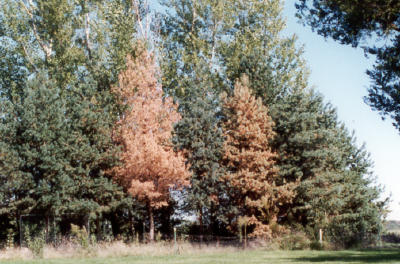 TOPEKA – The Kansas Department of Agriculture is encouraging Kansans with dead pine trees to properly remove the trees during the month of April.
TOPEKA – The Kansas Department of Agriculture is encouraging Kansans with dead pine trees to properly remove the trees during the month of April.
Pine trees that are killed by the pine wilt disease could be a host for the pine sawyer beetle that moves the disease from tree to tree. Pine sawyers are a fast moving parasite that burrows into pine trees feeding on resin canals. Pine sawyers generally emerge from dead pine trees in May and continue through July.
Kansas Department of Agriculture Plant Pathologist Jon Appel says homeowners should take the dead pine trees to a nearby landfill where the trees will be burned. The wood may also be chipped or buried to stop the cycle. However, these chips should not be used as mulch on pines. Wood from a removed pine tree also should not be used for firewood.
Pine wilt is a disease specific to pines. Pines affected in Kansas include Scotch, Austrian, Mugo (shrub pine) and a few others. The disease is generally not found in native North American pines such as the Ponderosa and Eastern White.
Pine wilt disease is established in the eastern half of Kansas but can still be controlled. The disease has been successfully eradicated in several communities of western Kansas.
The Kansas Department of Agriculture, Kansas Forest Service, Kansas State University and Extension Service, landowners and horticulture groups are working to limit, delay and mitigate the spread of pine wilt disease into the western half of Kansas through the Pine Wilt Initiative.
In addition to removing dead trees, Kansans with pines displaying pine wilt symptoms should notify their local extension agent or the Kansas Department of Agriculture Plant Protection Program at 785-862-2180. Symptoms include wilting and needles turning a dull green. If conditions are hot and dry, the tree rapidly dies, with needles turning brown and resin stopping to flow.
